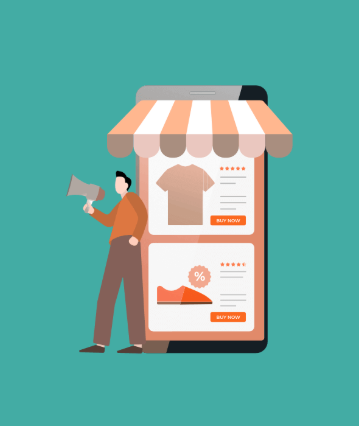Ecommerce advertising can feel like a game of chess where every move is critical. With numerous platforms and ad types available, it’s easy to become overwhelmed by all the options. However, with the right strategy, you’re not just aiming to compete—you’re aiming to win.
So, how can you create ads that actually lead to conversions? Which platforms deserve your marketing dollars? And what are the strategies top brands are using right now that you could adopt? We spoke to Irina, an expert in ecommerce advertising at TCF, to get her insights on making the most out of your campaigns. If you’re ready to take your advertising game to the next level, this guide is for you.
What is Ecommerce Advertising?
Ecommerce advertising refers to the practice of promoting products or services online to attract potential customers, drive traffic to your store, and increase sales. Rather than simply placing ads and hoping for the best, ecommerce advertising is about reaching the right people, at the right time, with the right message.
Ecommerce ads can appear across various platforms like search engines, social media, websites, and even in emails. Whether it’s a Google search for a product or an eye-catching TikTok ad, ecommerce ads keep your brand visible in the vast online marketplace.
Why Ecommerce Advertising is Important
- Increases Brand Awareness: If your potential customers don’t know about you, they can’t buy from you. Ecommerce advertising introduces your brand to new audiences.
- Boosts Revenue: With the right approach, every dollar spent on advertising should result in several dollars in sales.
- Keeps You Competitive: If you’re not advertising, your competitors certainly are—and they may be taking customers that could have been yours.
Ecommerce advertising helps your brand become visible, memorable, and most importantly, purchase-worthy. The challenge, however, is mastering it in a crowded market.
Types of Ecommerce Advertising
Not all advertising is the same. Each platform offers unique benefits, and knowing which one to use can make or break your campaign. Here’s an overview of the most common types of ecommerce advertising:
1. Search Engine Advertising (Google Ads, Bing Ads)
Search engine advertising appears when users search for specific terms, like “best wireless headphones.” These ads target consumers who are already looking for products, making them highly effective at driving conversions.
Why it works:
- Targets people when they’re actively looking to buy.
- Uses keywords to align ads with search intent.
- Pay-per-click (PPC) model ensures you only pay when someone clicks.
Best for: Products that are frequently searched, such as electronics, home goods, and beauty products.
2. Social Media Advertising (Facebook, Instagram, TikTok, Pinterest, LinkedIn)
Social media ads show up as sponsored posts or stories on platforms like Instagram and TikTok. These ads are visually driven and appear even when users are not specifically searching for products.
Why it works:
- Highly engaging formats, such as videos, carousel ads, and stories, drive more interaction.
- Advanced targeting based on demographics, interests, and behavior.
- Ideal for brand awareness and product discovery.
Best for: Fashion, beauty, fitness, and lifestyle brands that rely on strong visual content and impulse buys.
3. Display Advertising (Banner Ads, Retargeting Ads)
Display ads are graphical ads that appear on websites, apps, and even in mobile games. They’re excellent for brand recall and can help re-engage visitors who’ve already interacted with your brand.
Why it works:
- Helps keep your brand visible even when users aren’t actively searching.
- Retargets visitors who didn’t purchase the first time.
- Can be placed on high-traffic websites that your target audience frequents.
Best for: Retargeting previous site visitors and boosting brand recall, especially for tech, travel, and lifestyle brands.
4. Native Advertising (Sponsored Content, In-Feed Ads)
Native ads blend seamlessly with the content of a webpage, making them less intrusive and more engaging than traditional ads. They often appear as “recommended” articles or content within feeds.
Why it works:
- Feels natural within the browsing experience, leading to higher engagement.
- Users are more likely to engage with ads because they don’t recognize them as traditional ads.
- Common on high-authority content platforms.
Best for: Content-driven brands, online courses, subscription boxes, and wellness products that benefit from storytelling.
5. Email Advertising (Newsletter Ads, Promotional Emails)
Email marketing is still one of the most effective forms of ecommerce advertising. Brands use email campaigns for product launches, flash sales, and abandoned cart recovery.
Why it works:
- Targets an audience that’s already familiar with your brand.
- Low cost with a high return on investment (ROI).
- Ideal for nurturing leads and promoting repeat purchases.
Best for: Brands with an engaged email list, like fashion, skincare, and wellness brands.
6. Video Advertising (YouTube, TikTok, Instagram Reels)
Video content continues to dominate the internet, and video ads are a great way to engage customers. Platforms like YouTube, TikTok, and Instagram Reels are perfect for ecommerce brands aiming to grab attention quickly.
Why it works:
- Videos capture attention through movement and sound.
- Perfect for demonstrating product features and benefits.
- TikTok, in particular, rewards video-first content.
Best for: Brands with visual products that benefit from demonstration, such as beauty products, gadgets, and fashion items.
Which Type Should You Prioritize?
Choosing the right type of ecommerce advertising depends on where your audience spends their time. Irina, an advertising expert, recommends focusing on platforms where your target market is most active. If you’re in the fashion or beauty industry, TikTok and Meta (Facebook/Instagram) are great options. For tech or electronics, Google Ads might be your best bet.
How to Build an Ecommerce Advertising Strategy
Without a well-thought-out strategy, your ads might not reach their full potential. Here’s how to create a strategy that works:
1. Choose the Right Platforms
The platforms you select should align with where your audience already is.
How to do it right:
- Focus on where your audience spends their time (e.g., fashion brands should consider Instagram and TikTok).
- Match the platform to your product (e.g., tech products perform better on Google).
- Start small with a couple of platforms and scale up as you see results.
2. Segment Your Audience
Your audience isn’t one-size-fits-all, so tailor your ads to their needs.
How to do it right:
- Cold audiences: Use eye-catching ads to introduce your brand to people who don’t know you.
- Warm audiences: Retarget site visitors and followers with more personalized ads.
- Hot audiences: Offer discounts or free shipping to cart abandoners or previous buyers.
3. Create Engaging Ad Creatives
If your ad creatives don’t grab attention, no amount of targeting will help. Make sure your ads stand out.
How to do it right:
- Test various formats, such as static images, videos, and carousel ads, to see what performs best.
- Customize your visuals to match your audience’s mindset.
- Demonstrate your product in action to highlight its value.
4. Structure Your Campaigns Effectively
How you organize your campaigns is key to tracking performance and maximizing results.
How to do it right:
- Use a three-campaign model: Prospecting, Retargeting, and Upselling.
- Set up Campaign Budget Optimization (CBO) to automatically allocate budget to high-performing ads.
5. Set Up Proper Tracking
Without tracking, you can’t improve. Make sure you have the right tools in place to measure success.
How to do it right:
- Install tracking tools like Meta Pixel and Google Analytics.
- Track conversions and key actions such as purchases and add-to-cart events.
6. Monitor Key Metrics
Keep a close eye on the performance of your campaigns.
Key metrics to track:
- ROAS (Return on Ad Spend)
- CTR (Click-Through Rate)
- CPC (Cost Per Click)
- CPA (Cost Per Acquisition)
Conclusion
Ecommerce advertising isn’t just about spending more—it’s about spending smarter. From selecting the right platform to crafting the perfect creative, every step of your strategy matters. By targeting the right audience, optimizing your ads, and continuously tracking key metrics, you can turn your ad budget into real, measurable growth.
If you’re ready to take your advertising to the next level, follow these expert strategies to maximize your ROI and drive long-term success.


